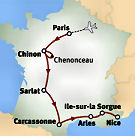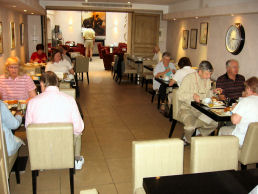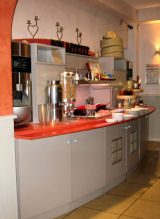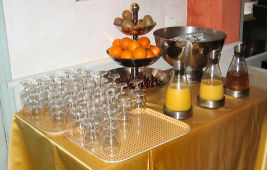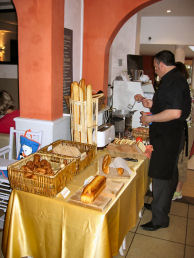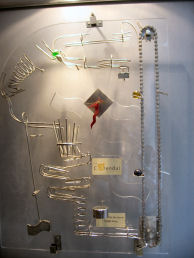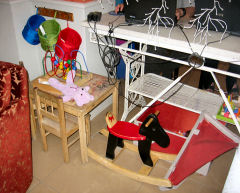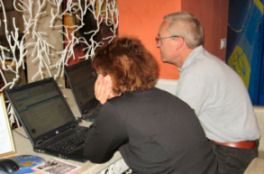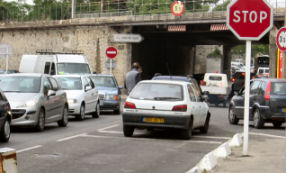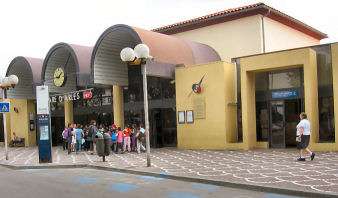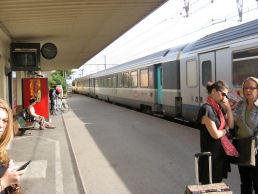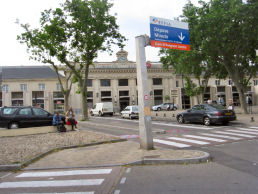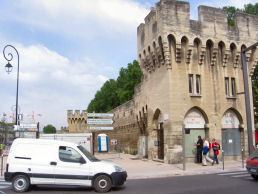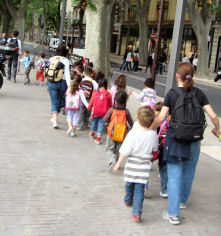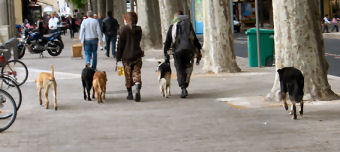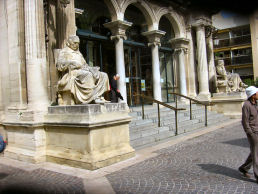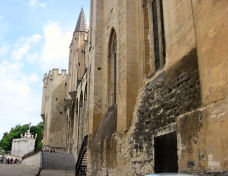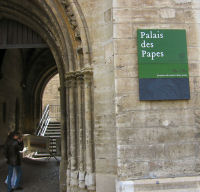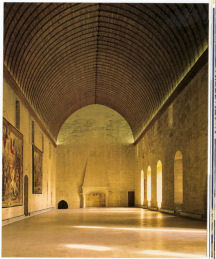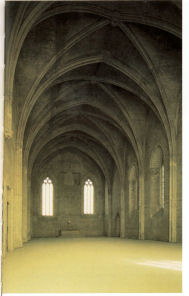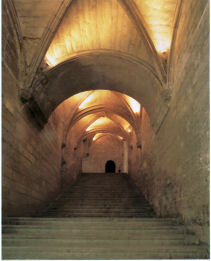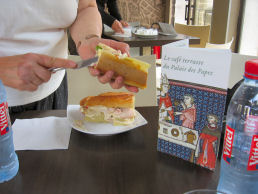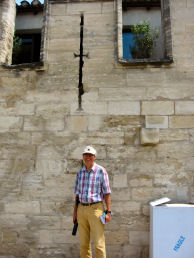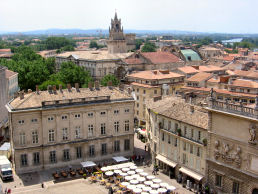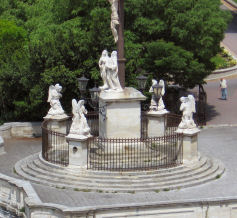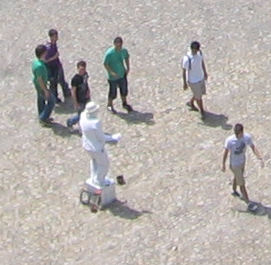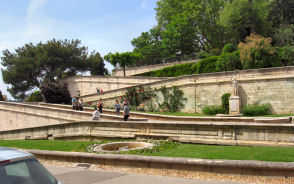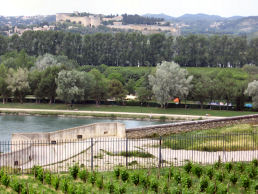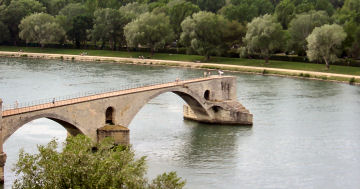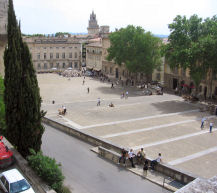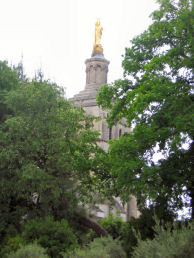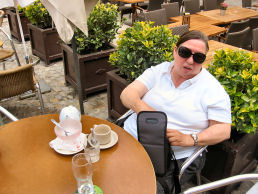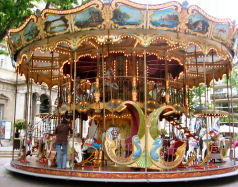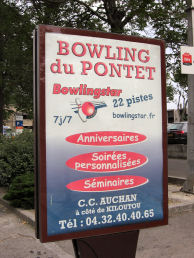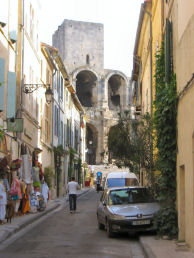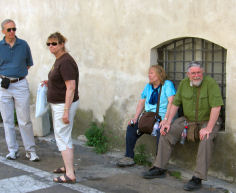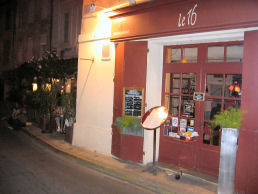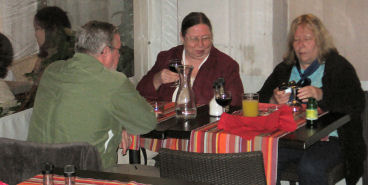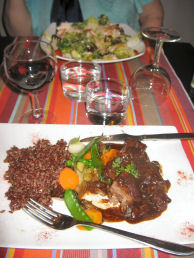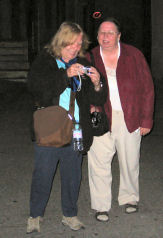I experienced no crazy dreams during the night, at least none that I could recall. Although my nose was still a little runny, I awoke feeling a little better than I had expected.
This was the day to which Sue and I had long been looking forward. The only thing on the schedule was a guided tour of Arles followed by free time to visit anything that we wanted to see. Sue and I planned to skip the tour and take the train up to Avignon and explore the Popes’ Palace and the other sights there.
I learned from the Internet that the Blackhawks had eliminated the Canucks from the chase for Lord Stanley’s cup. A tsunami in Vancouver would have been more unwelcome news for our Canadian contingent, but not by much.
The hotel had quarantined our group into a special Rick Steves section. There were quite a few people already eating when Sue and I stumbled downstairs. I found the breakfast a little frustrating. The primary challenge was dealing with the coffee machine. The first time I managed to concoct something drinkable by first pressing the “ristretto” button. Then I filled the cup with hot water and added half a teaspoon of Nescafe. The second time, however, I pressed the “cappuccino” button and got something that I found undrinkable. Loraine announced to everyone eating breakfast that all she wanted to do on our free day was to take a long shower. However, Nancy warned her that there probably would not be enough hot water. I made myself a sandwich of cold cuts on pre-sliced bread, the first of the latter that I had seen in France. I drank two glasses of orange juice. Sue had an egg. She expected it to be hard-boiled, but it was well short of that.We left the hotel for the train station at a little after 8:30. I followed the little map on which I had plotted the route to the train station. We would have easily made the 9:18 train if I had not missed the street that was right after the roundabout. It just did not look like a real street to me, and we were past it before I started searching.
A little farther on we heard two cars collide behind us. One had rear-ended the other at low speed. The two drivers got out of their cars and bickered while they held up traffic at one of the busiest intersections in Arles. A little further up we found a small train station, but I was sure that the real train station was on the other side of the tracks. So, we retraced our steps back toward the roundabout.
We came upon the two drivers again. They were still exchanging information, but they had at this point pulled their cars off to the side of the road. After we found the right street, we passed some construction and shortly arrived at the train station. I must have been completely discombobulated. For the first time on the whole trip I had forgotten to bring my spiral notebook. I would need to rely on what was left of my memory unless I could find some suitable writing materials. I also neglected to bring my water bottle, but that problem was easily remedied once we entered the station. Neither of us was in a good mood. Sue’s leg was bothering her, and I was upset at myself for being so scatterbrained. Sue stood in line to purchase tickets for Avignon. Meanwhile, I tried to get the ticket machine to work, but I had no luck. By the time that Sue got to the front of the line, the Avignon train had come and gone. This development did not improve our mental outlook. Sue purchased tickets for the next train.
The toilets in the train station were not functioning at all. There was a sign that directed people where to go, but we could make no sense of it. I bought a bottle of water at the small stand at the station. I looked for something – anything – to write on, but I could not find any paper that was blank on one side. Sue picked up a train schedule so that we could plan our return trip, but I was convinced that it did not have all of the Avignon-Arles trains on it.
We did not have to wait very long. The 9:50 train was right on time. We shared a compartment with a guy with curly grey hair. He was on his cell phone for the entire eighteen-minute journey. The conductor came by and checked our tickets. By some miracle we had remembered to get them stamped in the station.Twice on the way to Avignon, TGV trains traveling in the opposite direction nearly blew us off of the track. It sounded like a small explosion when they zoomed by.
Avignon seemed more peaceful to us than Arles. From the train station we walked down the tree-lined Rue de la République to the TI. Sue got us a (worthless) pass and a map. She also picked up some small pieces of scrap paper for me to use for notes. We then adjourned to the little park next door to take a break before continuing down to the Popes’ Palace. Sue used the public toilet, but it was devoid of toilet paper. I offered to return the small package of Kleenexes that she had given me at the Pont du Gard, but she reckoned that she had a sufficient supply. While Sue was using the facilities, I consulted the guidebook to plan out our day in Avignon. We had nothing else scheduled for the entire day, so I thought that we could reasonably follow the plan recommended in the book even if we went at half speed. That was when I noticed that nearly all of the museums in Avignon were closed on Tuesday. Well, at least the Popes’ Palace was open, and that was the main reason for this junket. We walked down Rue de la République toward the Popes’ Palace. We stopped for a few minutes in the Place de l’Horloge. While Sue was getting her breath, I checked out the opera house, which was right on the square. Its season was over, but I could hear someone playing the piano within. I also inspected the large merry-go-round.The exterior of the Popes’ Palace was even more austere than I had expected. It basically looked like a huge uninviting block of stone. I could not imagine Italian architects coming up with such a design. It was easy to see how (anti) Pope Benedict XIII was able to keep at bay the army of the French king for five years. I still had to wonder how he supplied himself and his entourage with the necessities of life for so many years with a hostile army parked on his doorstep.
We purchased our tickets and then we picked up our audio guides. At the same time I had to surrender my backpack. I stupidly neglected to retrieve my water bottle from it. I really had my head on crooked all day.
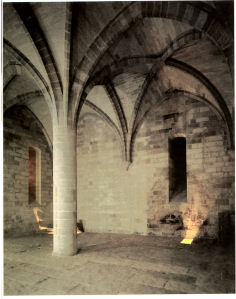
I struck gold in the Jesus Hall. Most of the rooms in the Popes’ Palace had the usual signs that explained something about how the room was used. They were all in French, so I did not get a great deal out of them. In this room, however, one two-sided sign contained pie charts detailing the various sources of income and expenses for several pontificates. Evidently the ledgers from most of the Babylonian Captivity were still in Avignon and had been painstakingly broken down by someone. I would gladly have paid 10€ to be able to take photos of these charts. I probably should have just copied them down, but I was too lazy. Based on my luck in Carcassonne, I banked on finding equivalent material in the bookstore.
The other rooms held substantially less interest for me. I already knew that the palace was both austere and gigantic. Seeing it only reinforced this idea. We were not even able to determine whether we visited the room in which Pope Clement VI holed up with his fire pits while the black death swept through the rest of Avignon. Nine cardinals succumbed to it. Sue and I ate lunch at the little café on the Terrasses. When we arrived there at about 1 p.m., only one person was there. Shortly after us a Scandinavian foursome showed up. By the time that we left, the place was pretty crowded.I overheard two sets of people speaking Italian. Two young couples were taking photos of one another and three older women seemed to be traveling as a group. I could pick up a few bits of the conversation, but not much. They might have been mixing in some dialect. The ladies seemed to be complaining about all the walking.
I had a very dry ham sandwich for lunch. The best endorsement that I could give was that it was food. Sue ordered a very wet chicken sandwich with lettuce, tomato, and mayonnaise. She was nice enough to let me eat half of it. It was much better than mine, but I got mayonnaise all over my face. Photos were permitted outside of the building. The area around the café was all open. We went up on the turret and got some pretty good snapshots and movies of the landscape, the façade, the courtyard, and the square below.Our plan was to take the little train that ran up to the Rocher des Doms, but the only train that we found went all over Avignon’s tourist area. That was not what I had in mind at all. Maybe the other one was not running. I decided to walk up to the park by myself. Sue found a sidewalk cafe with an umbrella for shade and ordered some ice cream.
The guidebook did not really say how to get to the park, but I need not have worried. Almost any direction worked, as long as you went up. The hike was not too bad, but Sue's knee would not have enjoyed it. I took quite a few pictures from the make-out point that the guidebook had emphasized. The view of the half-bridge was pretty good. I took a different route back. It gave me the opportunity to snap some shots of the cathedral and the Popes’ Palace.I easily found Sue and sat beside her at her table. The waiter immediately descended upon us, so I ordered a beer. Sue has never liked being in the sun, and she was somewhat miffed that the café had taken down the umbrellas due to the gusts of wind.
After a few relaxing minutes we walked back to the train station. The carousel in the Place de L'Horloge was in motion. One little girl was riding in a seat on it; her mother stood nearby to make sure that she did not get too scared. It must have been the kid’s first time; the seat that she occupied did not even go up and down. The walk back to the train station seemed shorter than the walk down to the Popes’ Palace. We somehow got mixed in with a handful of teenage guys who seemed to know everyone on the street. Sue speculated beneath her breath that one of them must have been the local drug dealer. We stopped for a short rest on the outskirts of the park next to the TI.As soon as we got to the station, we took our place in line at the ticket counter. Only one of the three agents admitted to speaking English. We learned from her that the next train would be leaving in thirty minutes, at 5:20. While we were there, we also purchased our tickets for the TGV from Turin to Paris on Monday.
Sue then went looking for the toilet. I found a seat in the waiting room and glanced through the book that I had bought at the Popes’ Palace. I found it disappointing. It was basically a transcript of the audio guide. There was some good information in it, but it did not seem to contain the pie charts or the data on which they were based. I would have preferred a translation of the material that was on the signs in the Jesus Hall. To reach our train we had to go downstairs beneath several sets of tracks. We arrived there about ten minutes early. Evidently this train, which was bound for Marseilles, originated in Avignon. It was already in place, and people were already boarding. It did not contain any compartments. Instead, it was configured with an aisle in the middle, just like Amtrak trains. Even though we sat in second class next to an open window, it was still quite warm inside the cat. It did not bother me, but Sue was wilting in the heat. Shortly after we left the station, a guy who could have passed for Rick Steves's father got up and closed our window. Evidently the breeze was blowing on him. His action did not make Sue happy at all. She considered moving to the other side where some windows were open, but she could not find a better place to sit. No one checked our tickets this time. We arrived in Arles promptly at 5:38. The walk back to the hotel did not seem as long as the walk down to the station, at least not to me. Near the arena we came upon the Corcorans and the Colwells. Tom said that he and Patti had eaten a late lunch and planned to eat supper at 9 p.m. That sounded good to Sue and me. We both craved a nap. I took a shower and then rested my eyes for a second. Patti knocked on our door at 8:30. If she had not, Sue and I both might have slept all night. We summoned up the energy to walk to the first restaurant that we found, Le 76, which was mentioned in the guidebook. We saw the Lantzes seated in the restaurant. They were just about to leave as we came in. When I asked them what they thought of the cuisine, Kathy said that they had only eaten salads.We found a table outside. Sue, Tom, and I ordered the black bull stew with red rice. The stew contained peapods and other vegetables. We all thought that it was pretty good. Patti ordered the chicken salad. We shared a bottle of red wine. Patti drank some kind of funny juice.
I felt a little rushed by the waiter. That was the only time on the entire trip that I felt such pressure. In general, once a customer at a French restaurant ordered something, he/she could stay at the table indefinitely.
As usual, as soon as we arrived back at the room, I downloaded my photos, cleared my camera, and went to sleep. One problem that I definitely had avoided on this trip was insomnia.
